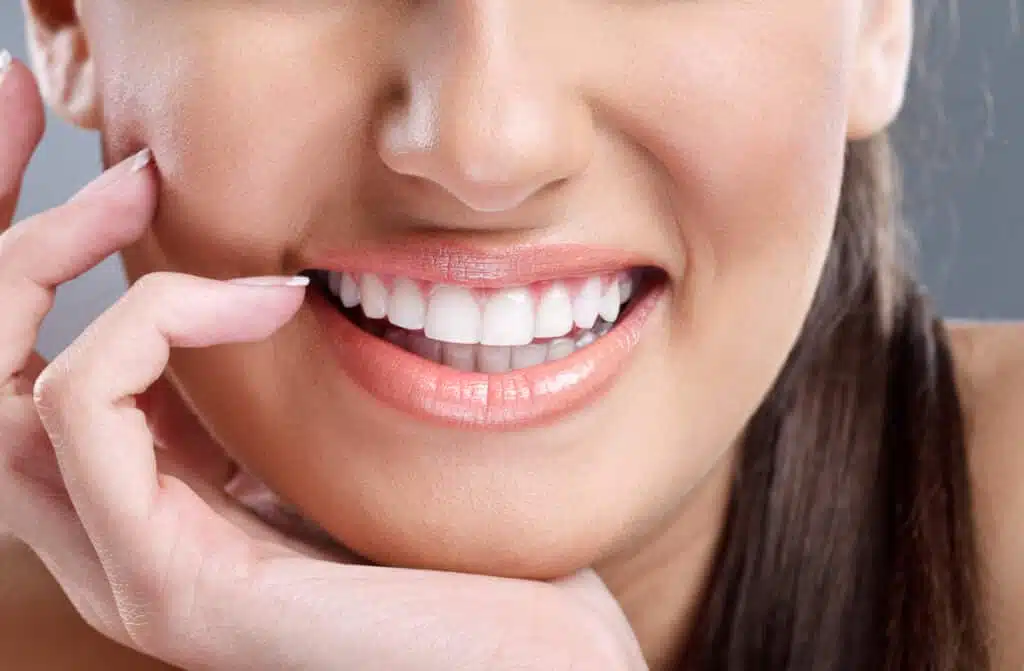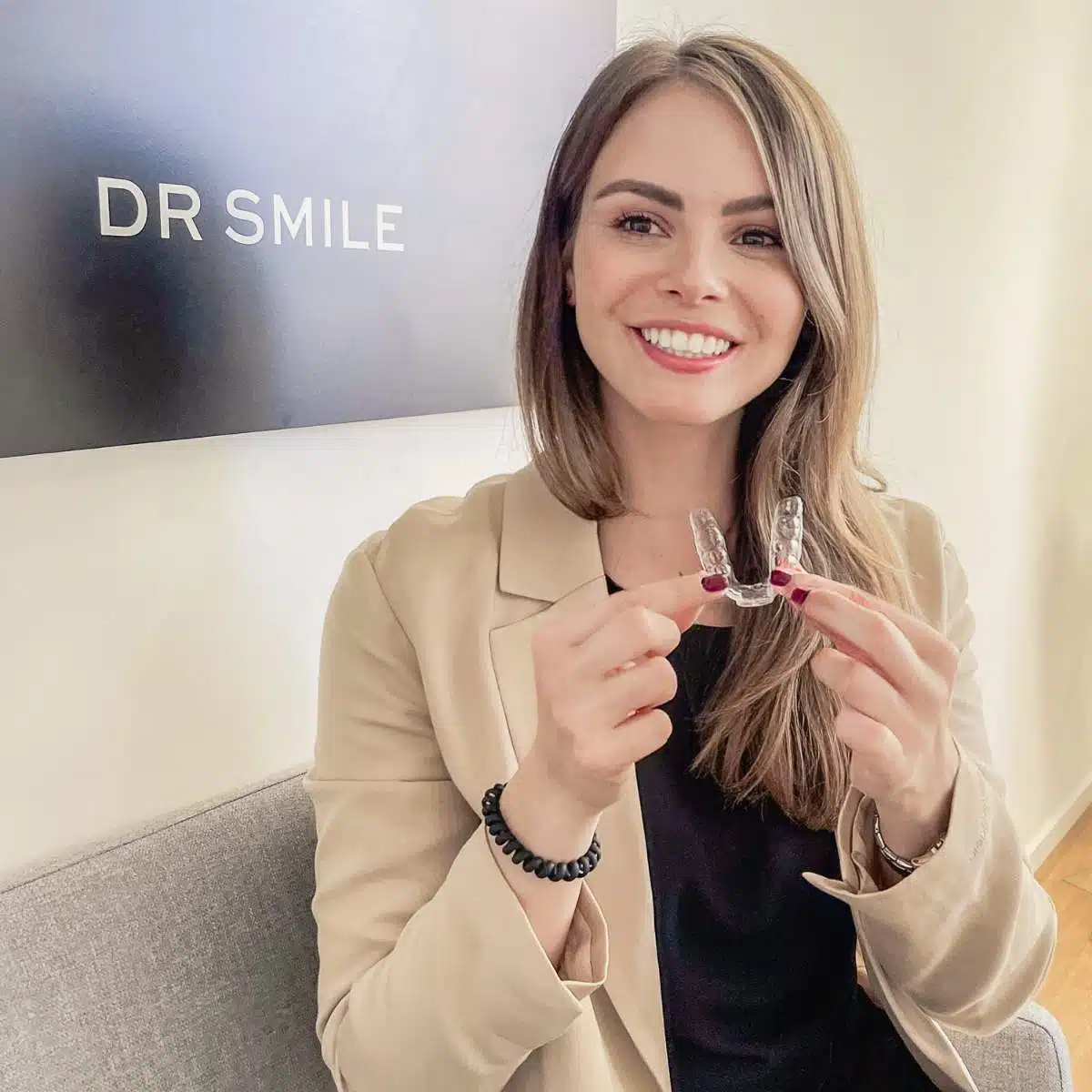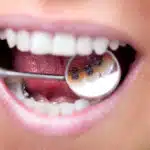Are your front teeth crooked and would you like to have them corrected? Here we present various options.
A radiant smile opens doors, boosts self-confidence and leaves a lasting impression.
But what if crooked front teeth prevent you from showing off your smile regularly and proudly?
First things first: you are not alone with this problem. Many people feel insecure about their crooked front teeth and look for ways to correct them.
In this blog post, we will introduce you to various options that will soon make your misaligned teeth a thing of the past.
| Get 150 € discount on your dental correction! |

Book a consultation appointment now at a nearby DrSmile partner practice and find out if teeth straightening with aligners is right for you.
The appointment is completely non-binding and does not involve any costs.
With the code “THATSMILE150” you will receive 150 € discount on the treatment.
From traditional braces to invisible aligners and other modern dental technologies, there are now more options than ever.
Find out now which method of tooth correction could be right for you and what the advantages and disadvantages are.

Crooked front teeth: These methods of tooth correction are available
Crooked front teeth – this is often not only an aesthetic problem, but can also affect self-esteem and lead to difficulties with oral hygiene.
In addition, the front teeth, of all things, are visible with every smile and in every conversation and are virtually impossible to hide.
Fortunately, modern dentistry has developed various effective methods to correct such misaligned teeth and give everyone a smile they can show off with pride.
In this article, we will introduce you to the various ways in which you can have crooked front teeth corrected.
1. classic braces
Traditional braces are one of the best-known methods for correcting misaligned teeth.
It consists of metal brackets that are bonded to the teeth and connected to each other by a wire.
Regular adjustments by the orthodontist ensure that the teeth are gradually shifted into the desired position.
Braces are particularly effective for complex malocclusions and can be used at any age.
Advantages of classic metal braces:
- Effectiveness: Very effective in correcting complex malocclusions and bite problems.
- Reliability: Long-proven method with predictable results.
Disadvantages of classic metal braces:
- Aesthetics: Metal brackets and wires are very conspicuous, which adults in particular can find disturbing.
- Comfort: May cause irritation and discomfort in the mouth at the beginning of treatment and after adjustments.
- Care: Makes tooth cleaning more difficult, which can increase the risk of gingivitis and tooth decay.
- Restrictions: Certain foods and drinks should be avoided so as not to damage the brackets or cause discoloration.
- Costs: Depending on the complexity of the misaligned teeth, traditional braces can be very expensive. The costs are generally not covered for adults.
2. invisible aligners
Invisible aligners, such as the products from DrSmile, consist of a series of clear, removable plastic aligners that are custom-made.
They are changed every two weeks to gradually bring the teeth into the correct position.
This method is particularly popular with adults as it is very discreet and the splints can be removed at any time.
Tip: Our recommendation for invisible braces (aligners) is DrSmile. Click through our further DrSmile articles here with all the important information about the aligner provider.
DrSmile has already produced more than one million aligners and can look back on over 150,000 completed tooth corrections.
DrSmile’s invisible aligners are already available in over 100 partner practices throughout Germany.
The company also offers not only a good price-performance ratio but also a satisfaction guarantee in case you are not one hundred percent happy with the result.
Advantages of aligners:
- Inconspicuous: clear plastic aligners are almost invisible, which is particularly popular with adults and teenagers who prefer discreet treatment.
- Removability: Aligners can be removed for eating, drinking, brushing, cleaning and special occasions, allowing for better oral hygiene.
- Comfort: Compared to traditional braces, aligners are often more comfortable to wear because they have no metal parts that could irritate the gums or the inside of the cheeks.
- Predictability: Modern 3D planning tools make it possible to predict the course of treatment and the final result.
- Costs: Invisible aligners are generally less expensive than fixed braces.
Disadvantages of aligners:
- Discipline required: For effective treatment, aligners must be worn for at least 20-22 hours per day. A lack of discipline can prolong the duration of treatment or impair the results.
- Not suitable for all cases: Severe malocclusions and bite problems may not be effectively treated with aligners.

3. lingual technique
Lingual brackets are bonded to the inside of the teeth and are therefore not visible from the outside.
So-called lingual braces work in a similar way to traditional braces, but without compromising on aesthetics.
This method is ideal for adults and adolescents who want an inconspicuous treatment.
However, lingual brackets can be uncomfortable at first and impair speech until you get used to them.
Advantages of lingual braces:
- Inconspicuous: As lingual braces are placed on the inside of the teeth, they are not visible from the outside, which makes them a very discreet treatment option.
- Effectiveness: They are suitable for correcting a wide range of malocclusions, including complex cases.
- No discoloration: Because the brackets are on the inside of the teeth, visible discoloration around the brackets is less likely than with traditional braces.
Disadvantages of lingual braces:
- Initial discomfort: At the beginning of treatment, speech problems and irritation of the tongue may occur until the mouth has become accustomed to the braces.
- Cleaning: Lingual braces can be more difficult to clean than traditional braces because they are less accessible.
- Cost: They are one of the most expensive orthodontic treatment options.
- Regular adjustments necessary: As with other braces, regular visits to the orthodontist are required to adjust the braces, which can be time-consuming.
| Get 150 € discount on your dental correction! |

Book a consultation appointment now at a nearby DrSmile partner practice and find out if teeth straightening with aligners is right for you.
The appointment is completely non-binding and does not involve any costs.
With the code “THATSMILE150” you will receive 150 € discount on the treatment.
4. veneers
Veneers are thin ceramic shells that are bonded to the front of the teeth to improve their appearance.
They offer a quick solution for crooked front teeth if the misalignment is only minimal.
Veneers can also correct the color and shape of teeth, but are a relatively invasive method as the tooth has to be slightly ground down to apply them.
Advantages of veneers:
- Aesthetics: Veneers provide a quick and significant improvement in the appearance of teeth, including color, shape and alignment.
- Resistance: They are resistant to stains from coffee, tea, smoking and other discoloring substances.
- Minimal tooth preparation: Compared to crowns, veneers require only minimal removal of tooth structure, which largely preserves the natural tooth.
- Longevity: With proper care, veneers can last for many years, often between 10 and 15 years.
- Fast results: The entire treatment can be completed in just a few visits, making it a quick fix for cosmetic concerns.
Disadvantages of veneers:
- Costs: Veneers are one of the more expensive cosmetic dental treatments.
- Irreversibility: As part of the tooth structure is removed to make room for the veneer, the process is irreversible and is considered invasive.
- Possible sensitivity: After the veneers have been fitted, there may be an increased sensitivity to hot or cold food and drinks.
- Risk of breakage: Although they are robust, veneers can break or become detached under high pressure, e.g. due to teeth grinding.
- No correction for severe malocclusions: Veneers are ideal for cosmetic corrections, but cannot provide a solution for severe misaligned teeth or malocclusion problems.
5. dental crowns
Dental crowns are a suitable option for certain problems, especially when teeth show signs of wear or damage in addition to being crooked.
These crowns cover the entire tooth and serve both to visually correct the tooth position and to restore stability and functionality.
Advantages of dental crowns:
- Restoring function: Crowns restore the functionality of severely damaged or worn teeth, enabling normal chewing and speaking.
- Aesthetics: They improve the appearance of discolored, badly shaped or crooked teeth and ensure a harmonious smile.
- Longevity: With proper care, dental crowns can last for many years, often even decades.
- Protection: Crowns provide robust protection for teeth that have previously been damaged by decay or injury and prevent further damage.
- Versatility: Available in different materials such as porcelain, ceramic, gold or a combination to meet different needs and budgets.
Disadvantages of dental crowns:
- Tooth preparation: In order to fit a crown, the tooth must be ground down, which is an irreversible procedure.
- Sensitivity: After the crown has been fitted, the tooth may temporarily react more sensitively to heat or cold.
- Cost: Dental crowns are one of the more expensive dental treatments.
- Risk of loosening or loss: Although rare, crowns can loosen or fall off completely, making re-treatment necessary.

Conclusion on the topic “Crooked front teeth – what can I do?”
Front teeth crooked? Then the decision to have your teeth corrected is an important step.
After all, it’s often not just about appearance, but also about general well-being and oral health.
Each method has its own advantages and disadvantages in terms of aesthetics, comfort, treatment duration and cost.
Today more than ever, modern tooth correction procedures make it possible to cater to the needs and wishes of each individual and effectively correct crooked front teeth without having to rely on traditional braces.
And ultimately, investing in a beautiful smile can boost self-confidence and lead to an improved attitude towards life.
Tip: For mild to moderate misalignments of the front teeth, we recommend invisible braces (aligners) from DrSmile.
I myself (the editor of this article) had my teeth (primarily my crooked front tooth) corrected with DrSmile and am still satisfied with the result of the treatment today.
Here I report on my personal DrSmile experiences.
| Get 150 € discount on your dental correction! |

Book a consultation appointment now at a nearby DrSmile partner practice and find out if teeth straightening with aligners is right for you.
The appointment is completely non-binding and does not involve any costs.
With the code “THATSMILE150” you will receive 150 € discount on the treatment.
FAQs on the topic “Crooked front teeth – what can I do?”
Here we answer a few of the most frequently asked questions on the subject of “Crooked front teeth – what can I do?”.
Why are my front teeth crooked?
Crooked front teeth can be caused by various factors, including genetic predisposition, early loss of milk teeth, habits such as thumb-sucking in childhood, or even accidents.
Do crooked front teeth affect my health?
Not necessarily. In some cases, however, problems such as difficulties in cleaning teeth, increased risk of tooth decay and gum disease, as well as jaw joint problems can occur.
Can I correct my crooked front teeth without braces?
Yes, there are several options such as invisible aligners, veneers or in some cases dental crowns that allow for correction without traditional braces.
Are invisible aligners as effective as traditional braces?
Yes for many cases, especially for mild to moderate misalignments. However, they may not be the most suitable option for more complex corrections.
How long does a treatment with invisible aligners take?
The duration of treatment varies depending on the complexity of the deformity, but is on average between 4 and 18 months.
Are veneers a permanent solution for crooked front teeth?
Veneers can provide a long-term solution, but may need to be replaced after a few years. They are particularly suitable for cosmetic corrections.
How can I prevent my teeth from becoming crooked again after the correction?
After the correction, it is important to wear a retainer splint to keep the teeth in their new position




Leave a Reply